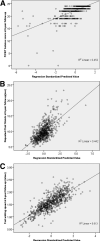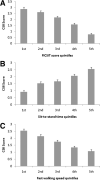Validity of clinically derived cumulative somatosensory impairment index
- PMID: 20159126
- PMCID: PMC2856325
- DOI: 10.1016/j.apmr.2009.10.006
Validity of clinically derived cumulative somatosensory impairment index
Abstract
Design: Prospective cohort study.
Setting: Population-based cohort.
Participants: InCHIANTI ("Invecchiare in Chianti" or aging in the Chianti area) study participants (N=960; age, 21-91 y, 51.8% women).
Interventions: Not applicable.
Main outcome measures: The Cumulative Somatosensory Impairment Index was derived from baseline performance on clinical tests of pressure sensitivity, vibration sensitivity, proprioception, and graphesthesia. Global postural control was assessed using Frailty and Injuries Cooperative Studies of Intervention Techniques (FICSIT) balance test, time to complete 5 repeated chair stands, and fast walking speed, at baseline and at 3-year follow-up.
Results: In participants without neurologic conditions (n=799), the Cumulative Somatosensory Impairment Index was significantly different in age groups classified by decades (P<.001). Compared with participants without prevalent conditions, the Cumulative Somatosensory Impairment Index was significantly higher in persons with diabetes (P=.017), peripheral arterial disease (P=.006), and a history of stroke (P<.001). In the overall population (N=960), in the fully adjusted multiple regression models, the Cumulative Somatosensory Impairment Index independently predicted deterioration in FICSIT scores (P=.002), time for 5 repeated chair stands (P<.001), and fast gait speed (P=.003) at 3-year follow-up.
Conclusions: The Cumulative Somatosensory Impairment Index is a valid measure that detects relevant group differences in lower limb somatosensory impairment and is an independent predictor of decline in postural control over 3 years.
Published by Elsevier Inc.
Figures



References
-
- Haridas C, Zehr EP. Coordinated interlimb compensatory responses to electrical stimulation of cutaneous nerves in the hand and foot during walking. J Neurophysiol. 2003;90:2850–61. - PubMed
-
- Sorensen KL, Hollands MA, Patla E. The effects of human ankle muscle vibration on posture and balance during adaptive locomotion. Exp Brain Res. 2002;143:24–34. - PubMed
-
- Wang TY, Lin SI. Sensitivity of plantar cutaneous sensation and postural stability. Clin Biomech (Bristol, Avon) 2008;23:493–9. - PubMed
-
- McDonnell M, Warden-Flood A. Effect of partial foot anaesthesia on normal gait. Aust J Physiother. 2000;46:115–20. - PubMed
Publication types
MeSH terms
Grants and funding
LinkOut - more resources
Full Text Sources
Medical

